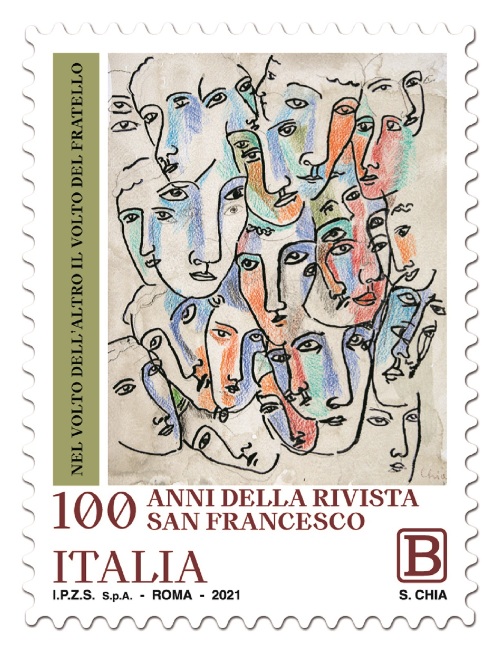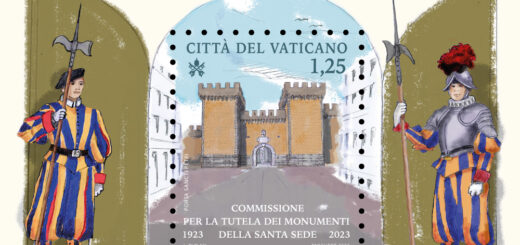POSTE ITALIANE – 36^ Emissione del 3 Novembre 2018 – Centenario della Vittoria
Titolo: Centenario della Vittoria
Il Ministero emette il 3 novembre 2018 un francobollo celebrativo del Centenario della Vittoria, relativo al valore della tariffa B. La vignetta riproduce l’affresco della Cappella Votiva eretta a ricordo dei Caduti della Grande Guerra, realizzato da Osvaldo Bignami nella Basilica di Santa Margherita in Cortona.
La prima guerra mondiale fu un conflitto armato che coinvolse le principali potenze mondiali e molte di quelle minori tra il luglio del 1914 e il novembre del 1918. Chiamata inizialmente dai contemporanei “guerra europea”, con il coinvolgimento successivo delle colonie dell’Impero britannico e di altri paesi extraeuropei tra cui gli Stati Uniti d’America e l’Impero giapponese prese il nome di guerra mondiale o anche Grande Guerra: fu infatti il più grande conflitto armato mai combattuto fino alla seconda guerra mondiale.
Il conflitto ebbe inizio il 28 luglio 1914 con la dichiarazione di guerra dell’Impero austro-ungarico al Regno di Serbia in seguito all’assassinio dell’arciduca Francesco Ferdinando d’Asburgo-Este, avvenuto il 28 giugno 1914 a Sarajevo. A causa del gioco di alleanze formatesi negli ultimi decenni del XIX secolo, la guerra vide schierarsi le maggiori potenze mondiali, e rispettive colonie, in due blocchi contrapposti: da una parte gli Imperi centrali (Germania, Impero austro-ungarico e Impero ottomano), dall’altra gli Alleati rappresentati principalmente da Francia, Regno Unito, Impero russo e, dal 1915, Italia. Oltre 70 milioni di uomini furono mobilitati in tutto il mondo (60 milioni solo in Europa) di cui oltre 9 milioni caddero sui campi di battaglia; si dovettero registrare anche circa 7 milioni di vittime civili, non solo per i diretti effetti delle operazioni di guerra ma anche per le conseguenti carestie ed epidemie.
Le prime operazioni militari del conflitto videro la fulminea avanzata dell’esercito tedesco in Belgio e nel nord della Francia, azione fermata però dagli anglo-francesi nel corso della prima battaglia della Marna nel settembre 1914; il contemporaneo attacco dei russi da est infranse le speranze tedesche in una guerra breve e vittoriosa, e il conflitto degenerò in una logorante guerra di trincea che si replicò su tutti i fronti e perdurò fino al termine delle ostilità. A mano a mano che procedeva, la guerra raggiunse una scala mondiale con la partecipazione di molte altre nazioni, come Bulgaria, Romania, Portogallo e Grecia; determinante per l’esito finale fu, nel 1917, l’ingresso in guerra degli Stati Uniti d’America a fianco degli Alleati.
La guerra si concluse definitivamente l’11 novembre 1918 quando la Germania, ultimo degli Imperi centrali a deporre le armi, firmò l’armistizio imposto dagli Alleati. Alcuni dei maggiori imperi esistenti al mondo – tedesco, austro-ungarico, ottomano e russo – si estinsero, generando diversi stati nazionali che ridisegnarono completamente la geografia politica dell’Europa.
Title: Centenary of Victory
The First World War was an armed conflict that involved the major world powers and many of the smaller ones between July 1914 and November 1918. Initially called by the contemporaries “European war”, with the subsequent involvement of the colonies of the British Empire and other non-European countries including the United States of America and the Japanese Empire took the name of World War or even Great War: it was in fact the largest armed conflict ever fought until the Second World War.
The conflict began on July 28, 1914 with the declaration of war of the Austro-Hungarian Empire to the Kingdom of Serbia following the assassination of Archduke Franz Ferdinand of Hapsburg-Este, which took place on June 28, 1914 in Sarajevo. Because of the game of alliances formed in the last decades of the nineteenth century, the war saw the major world powers, and respective colonies, in two opposing blocs: on the one hand the central Empires (Germany, Austro-Hungarian Empire and Ottoman Empire), on the other, the Allies represented mainly by France, the United Kingdom, the Russian Empire and, since 1915, Italy. Over 70 million men were mobilized all over the world (60 million in Europe alone) of which over 9 million fell on the battlefields; about 7 million civilian victims had to be registered, not only for the direct effects of war operations but also for the resulting famines and epidemics.
The first military operations of the conflict saw the lightning advance of the German army in Belgium and northern France, an action halted by the Anglo-French during the first battle of the Marne in September 1914; the contemporary attack of the Russians from the east broke German hopes in a short and victorious war, and the conflict degenerated into a weary trench war that replied on all fronts and persisted until the end of hostilities. As it progressed, the war reached a world scale with the participation of many other nations, such as Bulgaria, Romania, Portugal and Greece; decisive for the final outcome was, in 1917, the entry into the war of the United States of America alongside the Allies.
The war ended definitively on 11 November 1918 when Germany, the last of the Central Empires to lay down its arms, signed the armistice imposed by the Allies. Some of the largest empires in the world – German, Austro-Hungarian, Ottoman and Russian – became extinct, generating several nation states that completely redesigned the political geography of Europe.
| data /date | 03.11.2018 |
| n. catalogo / n. catalog | Michel 4073 – YT 3834 – UN 3916 |
| dentellatura/Serration | 11 |
| stampa/printing | fustellatura – rotocalco |
| tipo di carta/paper type | bianca patinata neutra |
| stampato | I.P.Z.S. Roma |
| tiratura | 1.000.000 |
| fogli/sheet | 28 |
| dimensioni/dimensions | 40 x 48 mm |
| disegnatore /designer | |
| tariffa francobollo | B =1.10 |







